Energy Savings Through Proper Use of Pneumatics
10 Tips for Saving Energy with Pneumatic Components and Systems
A renaissance in pneumatic automation technology today is creating the most productive, efficient, and flexible pneumatic motion actuation ever achieved. At the same time, energy costs and environmental legislations are rising, which means that manufacturing organizations are looking for ways to decrease operating costs while minimizing impact on the environment. How do these energy and legislative trends mesh with the use of pneumatic systems?
Actually, they fit quite well. Pneumatic energy-saving strategies, as outlined in this article, decrease plant energy consumption and minimize overall carbon footprint of the facility. And proper management of these resources leads to additional bottom line improvements – lower acquisition cost of pneumatic components and systems, and faster ROI on those acquisitions. Lower costs, higher performance, and more flexibility help contribute to greater overall competitiveness.
Energy costs and legislation trends
At the time of this writing in late October 2013, the U.S. Energy Information Administration anticipates that by the end of the year, the United States will be the world’s premier producer of petroleum and natural gas hydrocarbons. This is good news in the short run, but global demand for fossil fuels will maintain upward pressure on energy costs. Demand primarily will be coming from a growing global middle class, which seeks the good life in terms of products, services, and energy. The United Nations reports the global middle class is expected to number 4.9 billion people by 2030, nearly triple today’s 1.8 billion. The global middle classes in China, India, and Brazil will propel their countries’ economies to account for nearly half of world output by 2050.
With the growth of energy consumption and consequent increases in greenhouse gas emissions, governmental regulation will also increase. The manufacturing operation that does not lower energy consumption and emissions today will be doing so tomorrow at a much higher cost.
Arthur Rosenfeld, nuclear physicist, formerly of the California Energy Commission, sums up the energy situation for businesses and individuals with these words: “The cheapest energy is what you don’t use.”
This article provides tips on decreasing the use of expensive energy in favor of the “cheapest” kind through the proper use of pneumatics. That cheap energy goes right to the bottom line. Electric motors, interestingly enough, are the real energy hogs standing between high energy bills today and cheap energy tomorrow.
Electric Motors and Drive Systems (EMDS)
According to the International Energy Agency, electric motors and drive systems (EMDS) are the largest single electricity end use, accounting for more than 40% of global electricity consumption. The agency states that 32% of EMDS used are attributed to compressors. Compressors, many of which are used for compressed air pneumatic systems, operate on average at only 5% to 10% efficiency.
This means that there is an enormous potential for energy saving. The International Energy Agency says in its report on motor-driven energy efficiency that “Huge energy-efficiency potential was found untapped in EMDS – around 25% of EMDS electricity use could be saved cost effectively, reducing total global electricity demand by about 10%.”
The Fraunhofer Institute, Munich, Germany, one of the largest application research organizations in the world, estimates that every production machine offers manufacturers the potential of a 15% energy savings. The following are tips for achieving that 15% savings through the proper use of pneumatic systems.
The move to save energy must come from the highest levels of the organization. Only then will departmental barriers to effective action be lowered and all aspects of the organization come together over energy reductions. It may be a few passionate and knowledgeable middle managers/subject matter experts who make the case for action, but it is up to leadership to provide the mandate and the vision.
Organizations seeking greater energy efficiencies form all-inclusive motivated teams to work together to solve the energy usage problem. Team members represent
- Purchasing
- Design
- Sales
- Production
- Maintenance
- Logistics
- Quality
Interdisciplinary teams focus on shared understanding of common problems and look for ways of removing barriers to the solution of those problems.
Senior management can also take the step of adopting the ISO energy standard 50001. This standard calls for an energy manager, a person who can help interdisciplinary teams see the bigger picture, develop a company-wide framework, and help fix targets and objectives to meet policy guidelines. Regardless of whether or not the organization is ready for an ISO 50001 effort, forming an all-inclusive team is foundational to the success of the effort.
Begin the machine design and optimization process through simulation of pneumatic components. The leading pneumatics suppliers offer dimensioning software that supports efficiency through simulation. Proper dimensioning can result in approximately 40% less compressed air consumption and on average a 10% reduction in acquisition cost. When buying machines, the manufacturer should ask the OEM if the company performed dimensioning. If not, the machine may use unnecessary amounts of power.
Table 1 shows the results of a dimensioning simulation of an actuator moving 12 kg blocks of cheese 250 mm (10 in.) at 60 cycles a minute for 8 hours a day over 200 days. One actuator had a bore size of 40 mm (1½ in.) and the other 32 mm (1¼ in.).
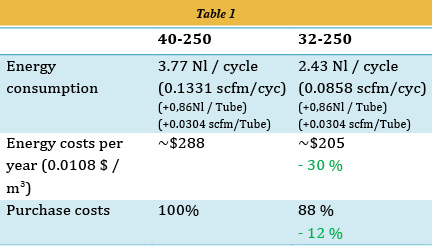
Research and experience have shown that even greater savings can be achieved by properly dimensioning paired systems. The reason is the safety factor that is built into each component. Taken separately, the safety factors of individual components exceed that of comparable paired systems and add cost and complexity.
Festo compared a palletizing system for a 12-kg gear part moving 500 mm at 20 cycles during an 8-hour shift for 200 days. The results are given in Table 2.
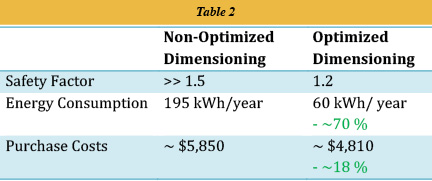
Adding pressure, differential pressure, and flow sensors to a machine can increase efficiency of the machine by providing the monitoring capability that alerts operators to out-of-specified conditions, such as high air pressure or low airflow rate, both of which might indicate a leak. For example, if there is a leak, operators might turn up the pressure to compensate and waste energy in the process. Changes in differential pressure indicate filters need cleaning or replacement. Clean filters ensure proper air flow, keep contaminates away from actuators, and help to prolong the service life and performance of valves and actuators.
Vacuum generation is an important tool in material handling. Vacuum is typically created using air flow through a venturi orifice. This is a process that consumes air. To make vacuum use more efficient, add an air-saving circuit. These circuits switch off air pressure when the required vacuum is achieved.
More savings can be achieved by replacing an expensive vacuum pump with less costly vacuum nozzles (Table 3).
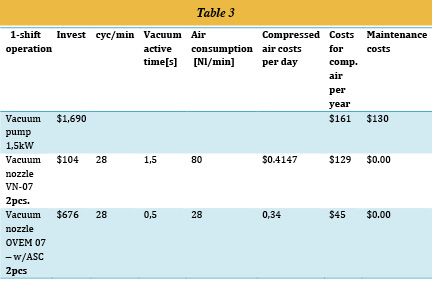
Use a pressure booster if the application requires high pressure, such as a force fitting. This strategy eliminates the need to increase pressure at the compressor. The pressure booster raises pressure where and when it is needed as opposed to creating a higher demand on the compressor.
Identify tubing systems, lengths, and diameters that, if changed, will result in savings. Long runs will be replaced by short ones wherever possible; small inner diameters replaced by correct dimensioning of pipe and hose diameters; cramped tube elbows will be replaced, as will unnecessary reductions, valves, and connectors. Wherever possible, closed circular pipelines will replace pipelines with dead ends.
One of the major improvements in pneumatic systems of the last several years has been the valve terminal, which allows valves to be located closer to actuators, thus shortening tube length. Table 4 shows an example of the kind of savings valve terminals offer by shortening runs.
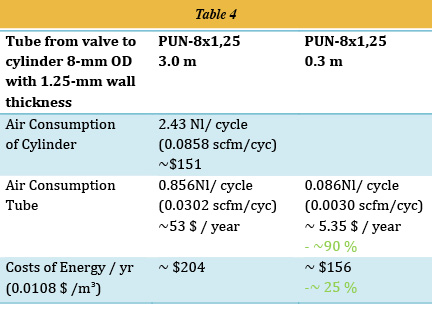
There are 12 broad areas of pneumatics where energy savings can effectively be made. Know and understand them:
- Correct dimensioning
- Reducing tube length
- Reducing leakages
- Reducing pressure drops
- Recovering energy
- Reducing pressure level
- Reducing flow rate
- Air-saving circuits
- Reducing friction
- Reducing weight
- Reducing energy consumption
- Switching off power
There are five energy-savings steps for existing systems. Plant personnel can and should perform some of these steps, while others will require experts with specialized equipment. Taken together, these steps will help to make the machines utilizing pneumatics more efficient.
Pre-assessment fact finding will document
- Actual energy situation
- Targets and needs
- Savings potential
- Recommended activities
Analysis of compressed air generation will be associated with
- Logging and analysis of the electrical consumption of the compressor(s)
- Logging of air consumption
- Calculation of actual energy costs
- Calculation of savings potential
- Recommended activities for making compressors more efficient
- Implementation of those recommendations
Air consumption analysis will involve
- Logging and analysis of air consumption
- Logging of leaks
- Identifying improper use of compressed air and possibilities for improvement
- Recommended activities for lowering air consumption
- Implementation of those recommendations
Leakage detection leading to
- Reducing pressure drops due to leakages
- Decreasing the consumption of compressed air and also operating costs
- Increasing process reliability
Analysis of air quality leading to
- Optimization of actual air quality in the compressed air system
- Increased machine availability and process reliability
- Decreased maintenance costs
It is clear that market and legislation trends are increasing not only the awareness of energy efficiency, but also the methods, tools, and willingness to begin the energy-efficiency journey. Correctly dimensioned and applied pneumatic systems are both efficient and vital elements to the operations of manufacturers. Efficiencies achieved go right to the organization’s bottom line.

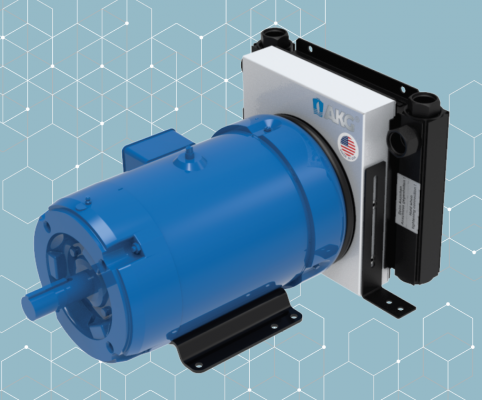

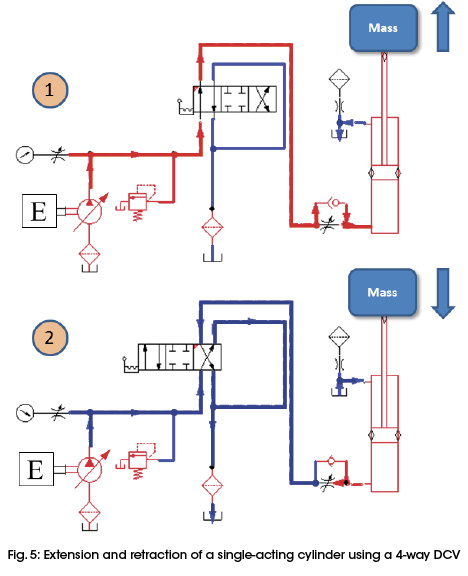


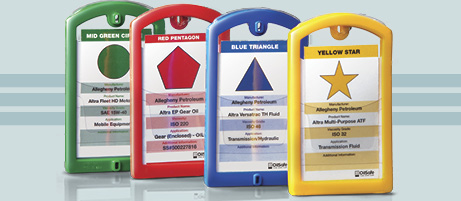

One thought on “Energy Savings Through Proper Use of Pneumatics”